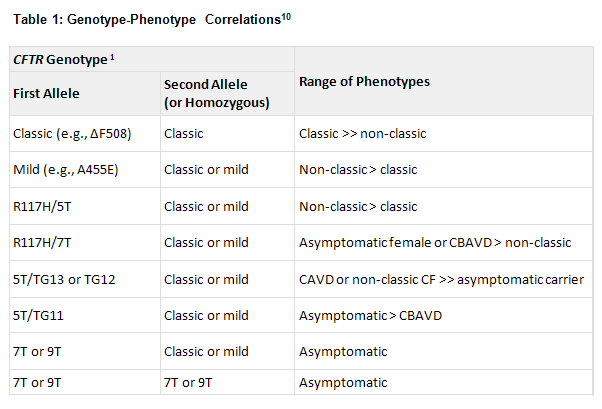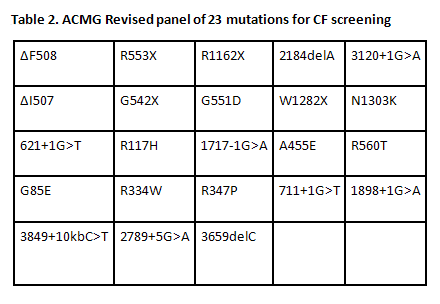
DISCUSSION
CYSTIC FIBROSIS
CF is the most common severe autosomal recessive disorder of the Caucasian population with a prevalence estimate of 1 in 2500 to 3300 live births. Since the identification of the CFTR (Cystic Fibrosis Transmembrane Conductance Regulator) gene in 1989, over 1900 mutations have been identified and updated at (http://www.genet.sickkids.on.ca/cftr).
Impaired function of the CFTR gene leads to defective chloride ion transport in a number of epithelial organs. Hence, CF is characterized by viscous mucus in the lungs with involvement of digestive and reproductive systems as well as sweat glands (excess salt loss). Pulmonary disease is the critical factor in prognosis/survival, but both pancreatic-sufficient and insufficient forms exist. Recurrent and persistent pulmonary infections are common and lead over time to respiratory failure. Pancreatic insufficiency occurs in 85% of affected individuals. Neonatal meconium ileus occurs in 10% to 20% of newborns with CF. Other manifestations may include chronic sinusitis, nasal polyps, liver disease, pancreatitis and congenital absence of the vas deferens. The overall average survival of CF patients, including those with milder presentation, is now ~35 years. Treatment for CF patients is palliative and includes control of infections, clearance of mucus in the lung and improvement of nutrition through pancreatic enzyme replacement.
CFTR mutations
There were initially four classes of CFTR mutations1,2,12,16 described on the basis of defects in protein production and function. These have been expanded to six classes recently. Mutations are situated throughout the entire coding region of the CFTR, to include the nucleotide binding (NBD) and regulatory (R) domains, as well as in the promoter region.
Class 1- defective protein production, Ex: G542X and R553X
Class II- defective protein processing, Ex: ?F508 mutation
Class III - defective regulation, Ex: G551D
Class IV - defective conduction, Ex: R117H
Class V -defective synthesis - abnormal splicing13
Class VI- affecting protein stability 3,4.
AS previously noted, these mutations result in defective cAMP-regulated chloride- secretion by epithelial cells of the sweat gland, airway, pancreas, and intestine.
Severe & Mild Mutations
Of the various clinical symptoms of CF only the pancreatic function has been shown to correlate well with CFTR genotype. Pulmonary disease is usually highly variable, even among sibs who have identical mutations. Severe mutations (i.e. Class I, II or III) where there is absence of functional CFTR correlate well with pancreatic insufficiency (>95% cases), liver disease (3-5% of patients), young age at diagnosis (usually <1 year), high sweat chloride levels (>80 meq/l) and meconium ileus (?20% of cases). 'Mild' mutations (i.e. Class IV, V, VI) which may still produce a small amount of functional CFTR are generally associated with pancreatic sufficiency (70-80% cases), a later age at diagnosis (usually >10 years), lower sweat chloride levels, no meconium ileus and milder pulmonary disease.
F508 & Other Common Mutations
A single mutation, F508del (a 3-nucleotide deletion that removes the phenylalanine residue at position 508 of CFTR, results in mis-folding of the CFTR protein and mislocalisation of the mature protein), and accounts for about 70% of CF chromosomes worldwide. The majority of other CFTR mutations seen with any frequency are relatively rare with four other mutations (G542X, N1303K, G551D and W1282X) having overall frequencies above 1% in the mixed Caucasian population. Certain 'founder' mutations are seen at higher frequencies in specific ethnic groups.
R117H
The R117H mutation is a Class IV mild mutation present in 0.3% of the Caucasian population can result in a wide variety of clinical outcomes depending on what other genetic variations are present.
Poly-T tract and the TG tract
Two regions in intron 8 of the CFTR gene, the Poly-T tract and the TG tract, have been demonstrated to impact CFTR function by aberrant splicing of exon 914,15. The Poly-T tract in the splice acceptor region occurs in 3 forms: 5T, 7T, and 9T. Bboth 7T and 9T alleles are considered polymorphic variants, but 5T alleles are considered variably penetrant mutations thought to decrease the efficiency of intron 8 splicing. Similarly, a region of dinucleotide repeats (the TG tract) located adjacent to the poly-T tract comes in 3 lengths called TG11, TG12, and TG13. and identified at the intron 8 - exon 9 junction. A longer TG tract (12 or 13) in conjunction with a shorter poly T tract (5T) has the strongest adverse effect on proper intron 8 splicing with resultant reduced expression CFTR mRNA containing exon 97,17. Up to 92% of CFTR mRNA transcripts can lack exon 9 without causing overt CF6.
The phenotypic consequences of the R117H mutation have been shown to be modulated in cis by the 5/7/9T polypyrimidine tract in intron 8 such that R117H/7T is associated with milder forms of CF such as CBAVD while R117H/5T alleles are may be associated with classic CF5. The 5T allele by itself has also been associated with male infertility due to CBAVD, with or without mild or atypical symptoms of CF. There is no known clinical significance of 5T in females. The penetrance of 5T effects is variable, and it is difficult to predict the clinical significance of the 5T variant.

This table is adapted from Moskowitz SM, Chmiel JF, Sternen DL, Cheng E, Cutting GR (Updated [19 February 2008]). CFTR-Related Disorders In: GeneReviews at GeneTests: Medical Genetics Information Resource (database online). Copyright, University of Washington, Seattle. 1997-2008. Available at http://www.genetests.org.
The patient described in this web case falls into the third group down in table 1 and appears to have non-classic cystic fibrosis.
Indications for Testing
Diagnostic Testing: for individuals showing classic or non-classic symptoms of cystic fibrosis, as well as atypical forms and infants with meconium ileus, also congenital bilateral absence of the vas deferens (CBAVD) in males.
Carrier Testing: in partners of individuals with a confirmed CFTR mutation or positive family history for CF, partners of CBAVD males, general population of reproductive couples, premarital population, to assist in selection of a mate, gamete donors.
Preimplantation/Prenatal Testing: positive family history, couples with a 1 in 4 risk (each carries a CFTR mutation), echogenic bowel in a fetus during second trimester, follow-up testing after newborn screening.
CF Screening Panel
Prepregnancy or premarital carrier screening of the mixed Caucasian population was recommend by an NIH consensus development conference in the late 1990s. In October of 2001, ACOG and ACMG recommended a panel of 25 mutations with 0.1% or greater frequency in CF patients worldwide for such screening. The panel was revised downward to 23 mutations after several years of experience (see below).11 These mutations With account for 94.04% to 88.29% of detectable mutations for individuals of mixed Caucasian background undergoing screening for CF.

ACMG's Other Recommendations on CF testing:
Standards and Guidelines of Reports on CF testing8
REFERENCES AND RESOURCES
![]() Contributed by Arivarasan Karunamurthy, MD. and Jeffrey A. Kant, MD, PhD
Contributed by Arivarasan Karunamurthy, MD. and Jeffrey A. Kant, MD, PhD